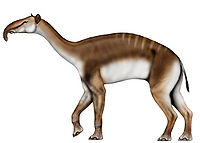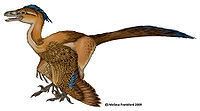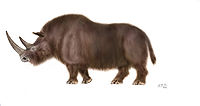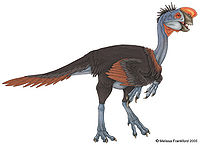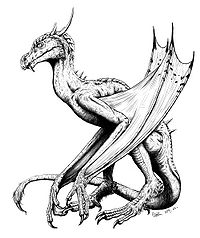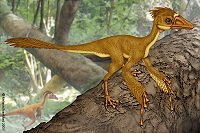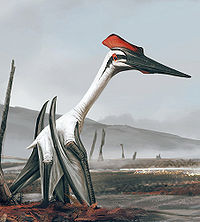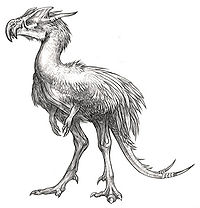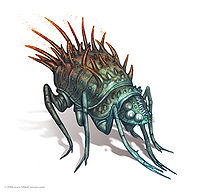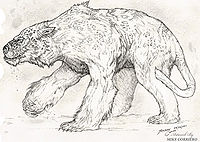From OtherSpace: Encyclopedia Galactica
| Line 5: | Line 5: | ||
==Herd Animals== | ==Herd Animals== | ||
| − | *'''Zik''' | + | [[File:Zik.jpg|200px|thumb|right|Zik]] |
| + | *'''Zik''' - The main meat animal of [[Pyracan]], it was once a herding grasslands animal and a very distant relative to the Satai. Thousands of years of selective breeding have allowed the ungulates to survive in almost any environment. They have also evolved a trust for Rickirr, which have been used to protect Zik since prehistory. Zik stand about four feet tall, with a short trunk used to strip leaves and pull up grasses, a long neck, rhinoceros-like feet, short brown fur with subtle striping near the rump, and a white underside. | ||
==Mounts== | ==Mounts== | ||
| Line 14: | Line 15: | ||
=Wild Animals= | =Wild Animals= | ||
| + | ==Avians== | ||
| + | [[File:Angler.jpg|200px|thumb|right|Angler, by Melissa Frankford]] | ||
| + | * '''Angler''' - Three feet tall, this flightless, gray-skinned avian-reptilian features brown feathers on the body and crest, burnt orange wing- and tailtips, and bright orange eyes, waddle and facial crest. It uses its shovel-like beak to create tide pools in the sides of moving streams, baiting them with bugs, then eating fish as they come to claim the bait. | ||
| + | [[File:Daja.jpg|200px|thumb|right|Daja]] | ||
| + | * '''Daja''' - With a height of over nine feet and a wingspan near thirty, this scaly-skinned heather-gray avian-reptilian has two swept-back horns and a line of spine ridges, with thin gray pinfeathers lining its legs and tailtip. Its long, serpentine tail ends in a tough, sharp claw, used to stab other males in dominance fights. It has been known to pick up prey over thirty pounds in weight and fly away with it, and thus can only be found in the most remote mountains, having been hunted out of existence in populated areas. | ||
| + | [[File:Meirle.jpg|200px|thumb|right|Meirle, by Melissa Frankford]] | ||
| + | * '''Meirle''' - Six inches in height, this flightless avian-reptilian features yellowish-brown skin, golden-brown feathers, and a light goldenrod underside. Omnivores, this jungle-dwelling opportunist eats bugs, berries, and is well-known for its boldness in stealing eggs of creatures much larger than itself. | ||
| + | [[File:Misg.jpg|200px|thumb|right|Misg, by Melissa Frankford]] | ||
| + | * '''Misg''' - Standing around four feet in height, this is a distant cousin to the much more successful group of avian-reptilians, with a hard beak and no wing-claws. It has dark gray skin, a long pointed beak, a swept-back red crest, tiny white feathers and a black streak going from its beak across its eye and down its long neck. It is awkward on land, known to waddle drunkenly, but is quite graceful in both sea and air, diving to catch small fish in its long beak. It is found in equatorial jungles. | ||
| + | [[File:Sealg.jpg|200px|thumb|right|Sealg]] | ||
| + | * '''Sealg''' - A distant cousin to the Daja, this flightless avian-reptilian is approximately six feet in height, with gray skin and reddish-brown feathers. It features two swept-back head ridges, two horns, a blunt snout with several overlapping facial projections, two tiny, useless forelimbs, and long, powerful legs. It can be found in grasslands, where it sprints up to forty miles an hour to run down prey, using its tooth-like projections to hold the victim down while it kicks it to death. | ||
| + | |||
==Bugs== | ==Bugs== | ||
* '''Danadas''' – A four foot long predatory millipede that lives in the arctic oceans, known for its boldness in attacking prey much larger than itself. | * '''Danadas''' – A four foot long predatory millipede that lives in the arctic oceans, known for its boldness in attacking prey much larger than itself. | ||
* '''Korole''' - Shaped like a three foot reddish-brown praying mantis, it is known for its ability to convincingly portray a piece of seaweed, and making its exoskeleton more pliable so as to flow in the movement of the water. Found in temperate ocean shallows. | * '''Korole''' - Shaped like a three foot reddish-brown praying mantis, it is known for its ability to convincingly portray a piece of seaweed, and making its exoskeleton more pliable so as to flow in the movement of the water. Found in temperate ocean shallows. | ||
| − | + | [[File:Matchbeetle.jpg|200px|thumb|right|Matchbeetle]] | |
| + | * '''Matchbeetle''' - A two inch long, six-legged insect, it is an icy blue-gray-green near its head tapering back to a dark blue gray towards its hind end, with over a dozen long spikes on its hindquarters that change from blue-gray to fiery orange when it feels threatened, creating a chemical reaction that makes the spikes heat to over six hundred degrees. Pyracani survivalists often set out capture-traps of iadh for these insects for their help in starting campfires. They are found in equatorial jungles. | ||
==Cephalopods== | ==Cephalopods== | ||
| Line 32: | Line 46: | ||
==Fish== | ==Fish== | ||
| − | * '''Salanas''' - A three foot long yellow and lime green striped fish with three large, showy yellow frills running the length of its head. Known as good eating. | + | * '''Daicheill''' - A bright red eel with electric blue flukes, it is said to have soft, succulent flesh, though the presence of a poison gland in the head tends to limit its distribution to those trained in removing the gland. Mildly popular as a large aquarium fish for its attractive coloration and streaks of electric blue bioluminescence, though it tends to kill most other fish, whether by its aggressive nature or the realease of poison in close quarters. Lives in the equatorial oceans. |
| + | * '''Dathte''' - With ragged metallic blue-on-white bull's-eye coloration on each flank like a tie-dye shirt, this six inch long fish escapes predators both through its sparkling-water camoflauge and its ability to jump and glide via its long fins, often for hundreds of feet. It is found in the oceans of Cuirrc Nation. | ||
| + | * '''Leisg''' - A two foot pink manta-like fish that hides from predators by burying itself amidst the sand in the shallow waters of Cuirrc Nation. The most popular seafood on Pyracan for its dense flesh and natural stick to hold it by for grilling and eating. | ||
| + | * '''Mairr''' - Found in the deep ocean, these fifty plus foot whale-like, gigantic distant cousins of the Rickirr use modified feathers over their gaping mouths to filter out microorganisms from the water, and use their long taloned forefins to dislodge parasites and to defend themselves against predators. | ||
| + | * '''Meanan''' - A common bait amongst fishermen, these lithe, four inch metallic teal fish gather in huge numbers in estuaries, where saltwater meets fresh. They are found the world over. | ||
| + | * '''Saill''' - Over ten feet in length and blubbery, these gray-blue arctic avian-like fish are caught for their blubber, which is used for frying a variety of dishes, being neutral in flavor. | ||
| + | * '''Salanas''' - A three foot long yellow and lime green striped fish with three large, showy yellow frills running the length of its head and long, lacy fins. Known as good eating, and found around Cuirrc Nation. | ||
| + | |||
==Mammals== | ==Mammals== | ||
Revision as of 14:48, 11 June 2011
Contents
Domesticated Animals
Food Animals
Aquaculture
- Unguli – Roaming in schools of up to a thousand, these quick, aerodynamic eight inch circular herbivorous invertibrates feature twelve triangular paddles and a solar organ for breaking up water into breathable elements. They are farmed in shallow ocean waters of temperate regions.
Herd Animals
- Zik - The main meat animal of Pyracan, it was once a herding grasslands animal and a very distant relative to the Satai. Thousands of years of selective breeding have allowed the ungulates to survive in almost any environment. They have also evolved a trust for Rickirr, which have been used to protect Zik since prehistory. Zik stand about four feet tall, with a short trunk used to strip leaves and pull up grasses, a long neck, rhinoceros-like feet, short brown fur with subtle striping near the rump, and a white underside.
Mounts
- Rickirr – 6-8 foot tall bipedal feathered lizard, originally used for herding, and now used as a quick and agile mount.
- Satai – A six foot tall shaggy rhinoceros-like creature, once used as a plow animal, but now used as a sturdy long-distance mount.
Wild Animals
Avians
- Angler - Three feet tall, this flightless, gray-skinned avian-reptilian features brown feathers on the body and crest, burnt orange wing- and tailtips, and bright orange eyes, waddle and facial crest. It uses its shovel-like beak to create tide pools in the sides of moving streams, baiting them with bugs, then eating fish as they come to claim the bait.
- Daja - With a height of over nine feet and a wingspan near thirty, this scaly-skinned heather-gray avian-reptilian has two swept-back horns and a line of spine ridges, with thin gray pinfeathers lining its legs and tailtip. Its long, serpentine tail ends in a tough, sharp claw, used to stab other males in dominance fights. It has been known to pick up prey over thirty pounds in weight and fly away with it, and thus can only be found in the most remote mountains, having been hunted out of existence in populated areas.
- Meirle - Six inches in height, this flightless avian-reptilian features yellowish-brown skin, golden-brown feathers, and a light goldenrod underside. Omnivores, this jungle-dwelling opportunist eats bugs, berries, and is well-known for its boldness in stealing eggs of creatures much larger than itself.
- Misg - Standing around four feet in height, this is a distant cousin to the much more successful group of avian-reptilians, with a hard beak and no wing-claws. It has dark gray skin, a long pointed beak, a swept-back red crest, tiny white feathers and a black streak going from its beak across its eye and down its long neck. It is awkward on land, known to waddle drunkenly, but is quite graceful in both sea and air, diving to catch small fish in its long beak. It is found in equatorial jungles.
- Sealg - A distant cousin to the Daja, this flightless avian-reptilian is approximately six feet in height, with gray skin and reddish-brown feathers. It features two swept-back head ridges, two horns, a blunt snout with several overlapping facial projections, two tiny, useless forelimbs, and long, powerful legs. It can be found in grasslands, where it sprints up to forty miles an hour to run down prey, using its tooth-like projections to hold the victim down while it kicks it to death.
Bugs
- Danadas – A four foot long predatory millipede that lives in the arctic oceans, known for its boldness in attacking prey much larger than itself.
- Korole - Shaped like a three foot reddish-brown praying mantis, it is known for its ability to convincingly portray a piece of seaweed, and making its exoskeleton more pliable so as to flow in the movement of the water. Found in temperate ocean shallows.
- Matchbeetle - A two inch long, six-legged insect, it is an icy blue-gray-green near its head tapering back to a dark blue gray towards its hind end, with over a dozen long spikes on its hindquarters that change from blue-gray to fiery orange when it feels threatened, creating a chemical reaction that makes the spikes heat to over six hundred degrees. Pyracani survivalists often set out capture-traps of iadh for these insects for their help in starting campfires. They are found in equatorial jungles.
Cephalopods
- Bolg – Found in equatorial oceans, this is a five foot long white tentacled animal shaped vaguely like a cross between a sea cucumber and a dirigible. A long oily stripe across their backs allows them to absorb sunlight and use the energy to break water into hydrogen and oxygen. The hydrogen is stored in a long gasbag, allowing them to fly above the water looking for prey, while the oxygen is slowly expelled out the back to allow for movement. When prey is found, the hydrogen is quickly dispelled, and the bolg drops down upon the prey, using its gigantic mouth to swallow it whole along with a good amount of sea water to start the floating process once more.
- Jegoro – The largest land animal on Pyracan, this ten-legged, five ton dark gray invertibrate behemoth with a single short gray horn looks like a cross between a squid and an elephant, and lives near the base of mountains in Chiarrain Nation. It utilizes its two massive front tentacles to pull biorr or large ferns from the ground and rips them into pieces to eat. While herbivorous, jegoro are still quite dangerous when threatened. It has become somewhat rare due to being hunted for its tough, flexible skin, which is used for backing armor. They have proven nearly impossible to domesticate, though it has been tried many times.
- Levicera – Ten foot long squid-like predator with its head hidden within a whorled shell with a wicked point. Tends to stab its prey, and then use its tentacles to draw the innards out for consumption. Lives in arctic oceans.
- Puinsean - Looking somewhat like an airborne, brightly color-shifting squid, this six inch long omnivore is highly poisonous. It exists in a sort of symbiotic relationship with the saighead flower, using the 1-2 gallon pools of water in the massive upturned flowers to power its hydrogen balloon-like flight and eating the floating dead insects that collect in these pools. In return, it both pollinates the flowers and poisons the pool so the flower can collect more insects and absorb some of the protein as the insects decay. It lives in equatorial jungles.
Crustaceans
- Falbhann – Looking like a cross between a starfish and a turtle, this twelve-legged crustacean is known as a slow but relentless predator, and almost impossible to kill while in the water. Its extremely hard shell is very difficult to crack, and it can lose a significant amount of its body and still be able to fully regenerate. It has been known to single-mindedly follow prey for weeks, outlasting instead of outrunning. It lives on equatorial seashores.
- Seapairr - Reaching almost four feet in length, these lazy, slow-moving gray-green crustaceans use their long upper limbs and strong claws to hang from biorr in the upper canopy of the forest for days at a time. They constantly munch on nearby sticks and leaves, only moving when they’ve defoliated an area. They live in temperate biorr forests.
- Seisd - About two feet in length, this squat black herbivorous crustacean uses its thick, sharp slicing arms to fell biorr and its dual tails to draw up piles of dirt to create enormous warrens for its extended family. While normally shy and fearful of Pyracani contact, it will use its slicing arms to fight to the death to protect its offspring. They live in temperate biorr forests.
- Zuni - Vaguely resembling a cross between a monkey and a spider, this foot-tall, 12-legged brachiate may be the most agile thing in the forest. Its six long, skinny upper legs are used to propel it through the dense vertical shafts of the temperate biorr forests at speeds of up to 50 miles per hour. Zuni are often kept as pets by wealthier Pyracani, and can be trained to do tricks. Stone gray with light brown stomachs in the wild, it’s been bred into various patterns of blue-gray, gray, black, white, tan, brown, and greenish-brown.
Fish
- Daicheill - A bright red eel with electric blue flukes, it is said to have soft, succulent flesh, though the presence of a poison gland in the head tends to limit its distribution to those trained in removing the gland. Mildly popular as a large aquarium fish for its attractive coloration and streaks of electric blue bioluminescence, though it tends to kill most other fish, whether by its aggressive nature or the realease of poison in close quarters. Lives in the equatorial oceans.
- Dathte - With ragged metallic blue-on-white bull's-eye coloration on each flank like a tie-dye shirt, this six inch long fish escapes predators both through its sparkling-water camoflauge and its ability to jump and glide via its long fins, often for hundreds of feet. It is found in the oceans of Cuirrc Nation.
- Leisg - A two foot pink manta-like fish that hides from predators by burying itself amidst the sand in the shallow waters of Cuirrc Nation. The most popular seafood on Pyracan for its dense flesh and natural stick to hold it by for grilling and eating.
- Mairr - Found in the deep ocean, these fifty plus foot whale-like, gigantic distant cousins of the Rickirr use modified feathers over their gaping mouths to filter out microorganisms from the water, and use their long taloned forefins to dislodge parasites and to defend themselves against predators.
- Meanan - A common bait amongst fishermen, these lithe, four inch metallic teal fish gather in huge numbers in estuaries, where saltwater meets fresh. They are found the world over.
- Saill - Over ten feet in length and blubbery, these gray-blue arctic avian-like fish are caught for their blubber, which is used for frying a variety of dishes, being neutral in flavor.
- Salanas - A three foot long yellow and lime green striped fish with three large, showy yellow frills running the length of its head and long, lacy fins. Known as good eating, and found around Cuirrc Nation.
Mammals
- Andarct - Seven foot tall omnivorous caninoid/ursinoid in patchy shades of gold, brown and tan. A distant relative of Pyracani. Lives where grasslands and forests meet the world over.
- Dallag – Foot-tall tan with dark brown stripes meercat-like burrowing rodents that make their homes in equatorial sand dunes.
- Itealaich – Resembling a black kangaroo rat, this biorr-climbing rodent’s tail is tightly folded behind it like a fan. When it senses danger, it jumps and fans open the stretchy tail into a parachute so it can travel safely down to the forest floor.
Single-Celled Organisms
- Malaya – Stretching sometimes for thousands of acres, herds of this small bright green, eel-like single-celled organism are a major pest to the Pyracani, as the inedible blobs clog nets and kill sea life. When their main predator, the bolg, was nearly wiped out a few hundred years ago, the creatures began to multiply unchecked, and now require yearly management to prevent them from choking off popular beach sites. They live in equatorial oceans.
- Iadh - Like an inch-long translucent eel, these gossamer green amoebas move via rippling their amazingly thin bodies like flags on a windy day. In a poorly-understood phenomenon, they absorb algae into themselves and somehow co-opt the plants’ powers of photosynthesis. In ancient times, the iadh were tied heavily to fairy stories, and some Pyracani are superstitious about large clouds of iadh to this day. They live in grasslands the world over.
Legends
- Aureus Lake Wyrm - First allegedly seen on June 6th, 2653, the Aureus Lake Wyrm is approximately fifty feet in length, its body about eight feet in diameter. It's segmented body has two pairs of legs for each section, each leg ending in a single spiked tip. It has a broad set of mandibles which are sharp and jagged where they meet. The creature has no perceivable eyes or external sensory organs. It may live in a cave at the bottom of the lake, having come up to the volcanic crater from deep within the planet's crust.
